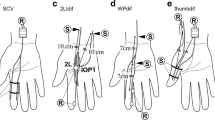Abstract
In the carpal tunnel syndrome (CTS), decreased conduction velocity (CV) of the median nerve in the forearm segment has been ascribed to an electrodiagnostic artefact rather than pathophysiological changes. Standard CV of the forearm segment is calculated by subtracting the distal latency, which may not represent an exact assessment of CV in the proximal median nerve. A new technique modified from the method of Stoehr et al. and Pease et al. can exactly measure CV over the forearm. Using this new technique, the forearm nerve action potentials (FNAP) amplitude and forearm nerve conduction velocity (FNCV) proximal to the wrist can be directly determined. Normal subjects and patients with CTS were studied by both the standard and the new FNAP methods. Patients were divided into subgroups according to the severity derived from standard electrodiagnostic findings. By comparing the normal control and patient subgroups, the results show that there was a significant decrease in FNAP amplitudes proportional to severity, but FNCV was reduced to a lesser extent. In addition, the standard forearm median motor CV (MMCV) correlated well with severity, but the reduced MMCV did not correlate with the decreased FNCV. These findings suggest that retrograde degeneration of the median nerve does exist in CTS; however, retrograde degeneration contributes little to the reduced forearm MMCV which substantially results from the block of faster conduction fibres at the wrist. Therefore, technique artefact plays a major role in causing the proximal slowing in the standard electrodiagnosis.
Similar content being viewed by others
References
Anderson MJ, Fullerton PM, Gilliatt RW, Hern JE (1970) Changes in the forearm associated with median nerve compression at the wrist in the guinea-pig. J Neurol Neurosurg Psychiatry 33:70–79
Buchthal F, Rosenfalck A, Trojaborg W (1974) Electrophysiological findings in entrapment of the median nerve at wrist and elbow. J Neurol Neurosurg Psychiatry 37:340–360
Cragg BG, Thomas PK (1961) Changes in conduction velocity and fiber size proximal to peripheral nerve lesions. J Physiol (Lond) 157:315–327
Daube JR (1977) Percutaneous palmar median nerve stimulation of carpal tunnel syndrome. Electroencephalogr Clin Neurophysiol 43:139–140
Delisa JA, Mackenzie K, Baran EM (1987) Manual of nerve conduction velocity and somatosensory evoked potentials. Raven Press, New York
Melvin JA, Schuchmann JA, Lanese RR (1973) Diagnostic specificity of motor and sensory nerve conduction variables in carpal tunnel syndrome. Arch Phys Med Rehabil 54:69–74
Pease WS, Lee HH, Johnson EW (1990) Forearm median nerve conduction velocity in carpal tunnel syndrome. Electromyogr Clin Neurophysiol 30:299–302
Shields RW (1988) Proximal slowing of median motor conduction velocity in carpal tunnel syndrome (abstract). Muscle Nerve 11:975
Simpson JA (1956) Electrical signs in the diagnosis of carpal tunnel and related syndromes. J Neurol Neurosurg Psychiatry 19:275–280
Stevens JC (1987) AAEE minimonograph no. 26. The electrodiagnosis of carpal tunnel syndrome. Muscle Nerve 10:99–113
Stoehr M, Petruch F, Scheglmann K, Schilling K (1978) Retrograde changes of nerve fibers with the carpal tunnel syndrome. J Neurol 218:287–297
Thomas JE, Lambert EH, Cseuz KA (1967) Electrodiagnostic aspects of the carpal tunnel syndrome. Arch Neurol 16:635–641
Thomas PK (1960) Motor nerve conduction in the carpal tunnel syndrome. Neurology 10:1045–1050
Thomas PK, Fullerton PM (1963) Nerve fibre size in the carpal tunnel syndrome. J Neurol Neurosurg Psychiatry 26:520–527
Author information
Authors and Affiliations
Rights and permissions
About this article
Cite this article
Change, MH., Liao, KK., Change, SP. et al. Proximal slowing in carpal tunnel syndrome resulting from either conduction block or retrograde degeneration. J Neurol 240, 287–290 (1993). https://doi.org/10.1007/BF00838163
Received:
Revised:
Accepted:
Issue Date:
DOI: https://doi.org/10.1007/BF00838163




